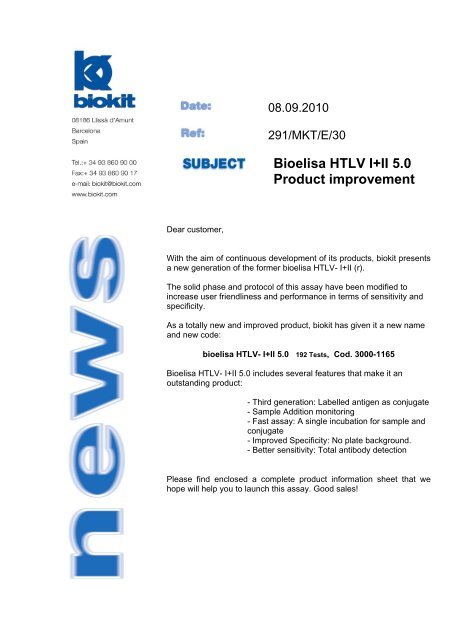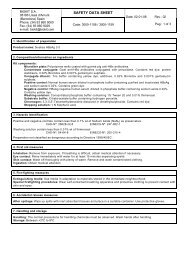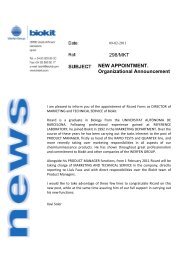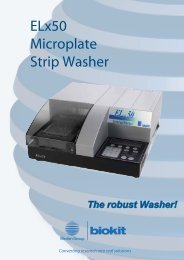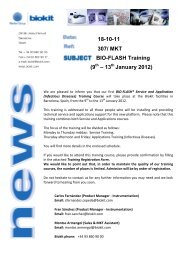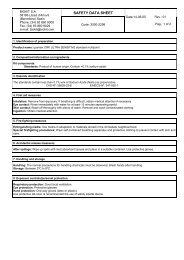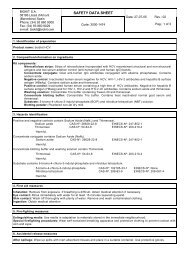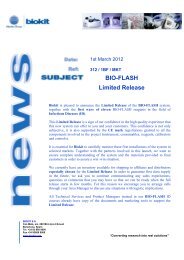Bioelisa HTLV I+II 5.0 Product improvement - Biokit
Bioelisa HTLV I+II 5.0 Product improvement - Biokit
Bioelisa HTLV I+II 5.0 Product improvement - Biokit
Create successful ePaper yourself
Turn your PDF publications into a flip-book with our unique Google optimized e-Paper software.
ioelisa <strong>HTLV</strong>-<strong>I+II</strong> <strong>5.0</strong><strong>Product</strong> <strong>improvement</strong>s:Recombinant antigensbioelisa <strong>HTLV</strong>-<strong>I+II</strong> <strong>5.0</strong> uses a combination of three epitopes collected in a single trifusionrecombinant antigen. The assay assures the detection of both <strong>HTLV</strong>-I and<strong>HTLV</strong>-II by two type specific epitopes derived from the ENV antigens: gp46 I from<strong>HTLV</strong>-I and gp46 II from <strong>HTLV</strong>-II. A third common ENV antigen, gp21, enhances thesensitivity and specificity for both <strong>HTLV</strong>-I and <strong>HTLV</strong>-II.gp21 is the best antigen for detecting <strong>HTLV</strong> as its correspondent antibody is thefirst to appear in the seroconversion of a patient. The gp21 recombinant is also avery specific antigen that does not cross-react with any other viral antigen.Third generation assaybioelisa <strong>HTLV</strong>-<strong>I+II</strong> <strong>5.0</strong> now uses a peroxidase labelled antigen as a conjugateinstead of the former anti-human IgG. It is a real sandwich assay in which all kindsof anti-<strong>HTLV</strong> class antibodies bind simultaneously to the plate coating andconjugate. Specificity and microplate background increases dramatically in thiskind of assay format.Protocol: Single incubation for sample and conjugatebioelisa <strong>HTLV</strong>-<strong>I+II</strong> <strong>5.0</strong> now uses a single incubation for sample and conjugate.Working conjugate is first dispensed into the microwells. The samples are thendispensed directly into the corresponding microwells. A change in the greentonality helps monitor sample addition. This change can also be readspectrophotometrically at 450 nm but definition of the OD limit must be validatedcustomer by customer.Sample and conjugate mixture is incubated for only one hour at 37 °C.After 6 wash cycles, ready-to-use TMB substrate is added and incubated for 30minutes at 37 °C.Test name bioelisa <strong>HTLV</strong>-<strong>I+II</strong> 4.0 bioelisa <strong>HTLV</strong>-<strong>I+II</strong> <strong>5.0</strong>Code number 3000-1156 3000-1165Method EIA/HRP/TMB EIA/HRP/TMBFormat 2 - step indirect method 1 - step direct sandwichSolid phase 12x8 Microtiter wells 12x8 Microtiter wellsTests per kit 192 192Coating Antigens Recombinant antigens Single tri-fusion Recombinant Antigen<strong>HTLV</strong>-I, <strong>HTLV</strong>-II gp46 I and gp46 II gp46 I and gp46 IICommon <strong>HTLV</strong> gp21 gp21ConjugateGoat anti-human IgG labelledwith HRP<strong>HTLV</strong> tri-fusion antigen labelled withHRPSubstrate TMB TMBSpecimen dilution 1/10 In plate dilution20 µl sample200 µl diluent1/2 In plate dilution50 µl Working conjugate50 µl Direct sampleSample incubation 60 min / 37°C 60 min / 37°CConjugate incubation 30 min / 37°C No ApplicableSubstrate incubation 15 min / 37°C 15 min / 37°CCut-off Mean Neg. + 0.450 Mean Neg. + 0.250Sensitivity 99.7% 100%Specificity 99.80% Blood donors 99.82% Blood donorsPage 2 of 9
Performance:Sensitivity:515 <strong>HTLV</strong>-I/II positive, 40 <strong>HTLV</strong> indeterminate and 11 <strong>HTLV</strong>-3/STLV-3 positivesamples were studied at three sites, one in-house and two in France. The results,summarised in table 1, show a detection rate of 100% for 515 confirmed <strong>HTLV</strong>-I/IIpositive samples, and nearly 72.7% (8/11) for <strong>HTLV</strong>-3/STLV-3 (simian counterpartof <strong>HTLV</strong>-3) positive samples.BBI <strong>HTLV</strong> mixed titer PRP 205 (M)bioblot <strong>HTLV</strong>Member <strong>HTLV</strong> typebioelisa <strong>HTLV</strong>-<strong>I+II</strong> <strong>5.0</strong> Ortho <strong>HTLV</strong>OD/COVOD/COVgp21 p19 p24 II IBBI-205-1 1 5.32 4.9 + + + +BBI-205-2 2 11.69 2.1 + + +BBI-205-3 2 39.40 4.1 + + +BBI-205-4 2 39.41 4.9 + + + +BBI-205-5 2 9.91 4.8 + + + +BBI-205-6 neg 0.11 0.3 No bandsBBI-205-7 1 13.8 4.9 + + + +BBI-205-8 2 4.00 2.5 + + + +BBI-205-9 2 1.24 (dil 1/20) 3.3 + + +BBI-205-10 2 NA 3.6 + + +BBI-205-11 1 39.4 4.7 + + + +BBI-205-12 1 8.39 4.7 + + + +BBI-205-13 2 5.60 3.1 + + + +BBI-205-14 1 1.84 4.6 + + + +bioblot <strong>HTLV</strong>Member <strong>HTLV</strong> typebioelisa <strong>HTLV</strong>-<strong>I+II</strong> Ortho <strong>HTLV</strong>OD/COVOD/COVgp21 p19 p24 II IBBI-205-15 1 NA 4.9 + + +BBI-205-16 2 11.32 3.9 + + + +BBI-205-17 1 4.65 4.9 + + + +BBI-205-18 2 39.40 4.2 + + +BBI-205-19 1 NA 4.3 + + +BBI-205-20 1 39.40 4.9 + + + +BBI-205-21 2 4.16 3.9 + + + +BBI-205-22 2 3.93 1.9 + + + +BBI-205-23 2 NA 1.8 + + +BBI-205-24 neg 0.11 0.2 No bandsBBI-205-25 1 39.4 4.9 + + + +Page 3 of 9
SpecificityA total of 5,306 samples comprised of random blood donor samples (n=5001),clinical samples (n=205) and potentially interfering samples (n=100) were tested.The results, summarised in table 2, show a diagnostic specificity of 99.82%(4990/4999) for the random blood donor, and 100% for clinical samples andpotentially interfering samples.Enclosed material: CE Mark Package insert Safety Data SheetPage 4 of 9
CE MARKPage 6 of 9
UL International (UK) LtdAn affiliate of Underwriters Laboratories Inc.EC Design – Examination Certificate(Annex IV section 4 of the Directive 98/79/EC on In Vitro Diagnostic Medical Devices)Manufacturer<strong>Biokit</strong> SACan Malé08186 Lliçà d’AmuntBarcelonaSpainAuthorised RepresentativeNot ApplicableModel Type:<strong>Bioelisa</strong> <strong>HTLV</strong>-<strong>I+II</strong> <strong>5.0</strong> product code 3000-1165 (192T)We hereby declare that a design examination has been carried out on the device(s) listed followingthe requirements of the national legislation to which the undersigned is subject, transposing AnnexIV section 4 of the Directive 98/79/EC on In Vitro Diagnostic Medical Devices. We certify that thedesign of the device(s) listed conforms with the relevant provisions of Annex IV section 4 of thedirective 98/79/EC on In Vitro Diagnostic Medical Devices as transposed into national legislation.Certificate issued by:Certification ManagerFor UL International (UK) LtdUL International (UK) LtdWonersh HouseThe GuildwayOld Portsmouth RoadGuildford, Surrey GU3 1LRUnited Kingdom+44 (0)1483 302130Certificate no: 601Original certificate: 10 June 2009Current certificate: 10 June 2009Certificate expiry: 02 March 20130843OBL Page 1 of 1
PACKAGE INSERTPage 7 of 9
ioelisabioelisa <strong>HTLV</strong>-<strong>I+II</strong> <strong>5.0</strong>READ HIGHLIGHTED CHANGES3000-1165 192 testsELISA test for the detection of antibodies to <strong>HTLV</strong>-I and <strong>HTLV</strong>-II in human serum or plasma. It is intendedas a screening test, requiring repeat testing of initially reactive samples.SummaryHuman T-cell Lymphotropic Viruses (<strong>HTLV</strong>s) are pathogenic retroviruses that may cause severe haematologicaland neurological diseases in infected individuals. The <strong>HTLV</strong> family comprises of two well-studied members:<strong>HTLV</strong>-I and <strong>HTLV</strong>-II, as well as two newly discovered members: <strong>HTLV</strong>-3 and <strong>HTLV</strong>-4. <strong>HTLV</strong>-I is known as theetiological agent of adult T-cell leukemia / lymphoma (ATL), <strong>HTLV</strong>-associated myelopathy / tropical spasticparaparesis (HAM/TSP), and <strong>HTLV</strong>-associated uveitis. <strong>HTLV</strong>-II infection has also been associated with leukemiaand neurological disease although it is less pathogenic than <strong>HTLV</strong>-I. Several lines of molecular evidencessuggest that <strong>HTLV</strong>-3 possesses some of the <strong>HTLV</strong>-I properties although little is known about the pathogenicityof <strong>HTLV</strong>-3.Studies of the geographic distribution of <strong>HTLV</strong>-I infection reveal that the virus is highly prevalent in Japan, Africa,Caribbean islands and South America. Recent epidemiological studies in the United States and Europe confirm thepresence of a mixed prevalence of both <strong>HTLV</strong>-I and <strong>HTLV</strong>-II among different high-risk populations, such asintravenous drug users and transfusion recipients. The viruses can be transmitted through sexual contact, andthrough contaminated blood products, and mother to child via breast-feeding.The bioelisa <strong>HTLV</strong>-<strong>I+II</strong> <strong>5.0</strong> is a direct sandwich immunoassay that utilises a combination of recombinantproteins and a tri-fusion recombinant protein labeled with horseradish peroxidase. This test format assuressimultaneous detection of various specific IgA, IgG and IgM antibodies against <strong>HTLV</strong>-I and <strong>HTLV</strong>-II. In addition,external tests had shown bioelisa <strong>HTLV</strong>-<strong>I+II</strong> <strong>5.0</strong> is capable of detecting antibodies to <strong>HTLV</strong>-3/STLV-3(see specific Performance Chapter).The bioelisa <strong>HTLV</strong>-<strong>I+II</strong> <strong>5.0</strong> is intended as a semi-quantitative enzyme-linked immunosorbent assay for thedetection of antibodies to both <strong>HTLV</strong>-I and <strong>HTLV</strong>-II found in human serum or plasma. It is intended as a first linescreen, requiring repeat testing of initially reactive specimens and confirmation of repeat reactive specimens bysupplemental assays.PrincipleThe wells of the polystyrene microplate strips are coated with a mixture of three different <strong>HTLV</strong> recombinantproteins, which correspond to the highly antigenic segments of <strong>HTLV</strong>-I and <strong>HTLV</strong>-II viruses. The conjugate isbased on a tri-fusion recombinant protein, which is labeled with horseradish peroxidase. The tri-fusion antigen isgenerated by cloning of three cDNA fragments coding for the three <strong>HTLV</strong> recombinant proteins into a single vector.Human serum or plasma, diluted in the diluent containing the conjugate, is incubated in a coated well. <strong>HTLV</strong>-I/IIspecific antibodies (IgA, IgG and IgM), if present, will bind to both the antigens immobilised on the solid phase andthe tri-fusion antigen of the conjugate. After incubation, the wells are thoroughly washed to remove unboundmaterials. A colorless substrate solution containing chromogen 3,3’, 5,5’ - tetramethylbenzidine (TMB) is thenadded to each well. The presence of specific antibodies is indicated by the presence of a blue colour afterincubation, which changes to yellow when the color reaction is terminated by the addition of sulphuric acid. Theintensity of the resulting yellow product is measured at 450nm using a spectrophotometer and is proportional to theamount of antibodies present in the sample.Components1. MCPL MICROPLATE:2 Plates of twelve 8-well strips. Each well contains adsorbed <strong>HTLV</strong>-I and-<strong>HTLV</strong>-II recombinant proteins. Storeat 2-8°C.2. CONTROL – NEGATIVE CONTROL:1 x 1.8 ml of normal human serum, non reactive for anti-HCV, anti-HIV-1/2, anti-<strong>HTLV</strong>-I/II and HBsAg.Contains thimerosal and sodium azide as preservatives. Store at 2-8°C.3. CONTROL + POSITIVE CONTROL:1 x 1.8 ml of inactivated human serum containing a high titre of IgG antibodies specific for <strong>HTLV</strong>-I/II and nonreactive for anti-HCV, anti-HIV-1/2 and HBsAg. Contains thimerosal and sodium azide as preservative.Store at 2-8°C.BIOKIT, S.A. - 08186 Lliçà d’Amunt - Barcelona - SPAIN08433000-1165 R02 03.2010 eng.doc
ioelisa4. DIL DILUENT:1 x 50 ml of phosphate buffered saline with casein and detergent. Contains Bronidox TM as preservative. Storeat 2-8°C.5. WASH SOLN 20x CONCENTRATE WASHING SOLUTION:1 x 120 ml of phosphate buffered saline with Tween-20. Contains chloracetamide as preservative. Storeat 2-8°C.6. CONJ CONJUGATE:1 x 160 µl of <strong>HTLV</strong> trifusion antigen labeled with horseradish peroxidase. Contains 0.02% thimerosal aspreservative. Store at 2-8°C.7. SUBS TMB SUBSTRATE-TMB:1 x 25 ml of colourless buffer containing 3,3’ 3,5’ - tetramethylbenzidine (TMB). Store in the dark at 2-8°C.8. H 2 SO 4 2M STOPPING SOLUTION:1 x 30 ml of 2M sulphuric acid solution. Store at 2-8°C.9. SEALS ADHESIVE SEALS:To cover the microplate during incubations.10. BAG RESEALABLE BAG:For storage of unused strips.* Bronidox is a Trade Mark of Henkel Chemical Co.Precautionsbioelisa <strong>HTLV</strong>-<strong>I+II</strong> <strong>5.0</strong> is intended for IN VITRO diagnostic use.For professional use only.Please refer to the product labelling for information on potentially hazardous components.HEALTH AND SAFETY INFORMATIONCAUTION: This kit contains materials of human origin. No test method can offer complete assurance that humanblood products will not transmit infection. HANDLE ASSAY SPECIMENS, POSITIVE AND NEGATIVECONTROLS AS POTENTIALLY INFECTIOUS AGENTS. It is recommended that the components and testspecimens be handled using good laboratory working practices. They should be disposed of in accordance withestablished safety procedures.The Positive Control and Negative Control contain 0.005% thimerosal and 0.1% sodium azide. Sodium azidecan react with copper and lead used in some plumbing systems to form explosive salts. The quantities used in thiskit are small, nevertheless when disposing of azide-containing materials they should be flushed away with relativelylarge quantities of water to prevent metal azide buildup in plumbing system. The following are the appropriate risk(R) and safety (S) phrases.Thimerosal:R26/27/28 Very toxic by inhalation, in contact with skin and if swallowed.S28-36-45 After contact with skin, wash immediately with plenty of water. Wear suitable protective clothing. Incase of accident or if you feel unwell, seek medical advice immediately (show the label wherepossible).Sodium Azide:R28-32 Very toxic if swallowed. Contact with acids liberates very toxic gas.S28-45 After contact with skin, wash immediately with plenty of water. In case of accident or if you feel unwell,seek medical advice immediately (show the label where possible).BIOKIT, S.A. - 08186 Lliçà d’Amunt - Barcelona - SPAIN08433000-1165 R02 03.2010 eng.doc
ioelisaThe Diluent contains 0.5% Bronidox, which is classified pursuant to applicable European Economic Community(EEC) Directives as irritant (Xi). The following are the appropriate risk (R) and safety (S) phrases.R22R38S36S46Harmful if swallowed.Irritating to skin.Wear suitable protective clothing.If swallowed, seek medical advice immediately and show this container or label.The Concentrate Washing Solution (20x) contains 2% chloroacetamide which is classified pursuant to applicableEuropean Economic Community (EEC) Directives as Irritant (Xi). The following are the appropriate risk (R) andsafety (S) phrases.R25 Toxic if swallowed.R43 May cause sensitization by skin contact.R62 Possible risk of impaired fertility.S22 Do not breathe dust.S36/37 Wear suitable protective clothing and gloves.S45 In case of accident or if you feel unwell, seek medical advice Immediately (show the label when possible).The Stopping Solution is 2M Sulphuric acid which is classified pursuant to applicable European EconomicCommunity (EEC) Directives as corrosive (C). The following are the appropriate risk (R) and safety (S) phrases.R35 Causes severe burns.S26-30-45 In case of contact with eyes, rinse immediately with plenty of water and seek medical advice. Neveradd water to this product. In case of accident or if you feel unwell, seek medical advice immediately(Show label where possible).1. Avoid microbial contamination of reagents when opening and removing aliquots from the original vials or bottles.2. Do not pipette by mouth.3. Handle assay specimens, microplates, Positive and Negative Controls as potentially infectious agents.4. Wear laboratory coats and disposable gloves while performing the assay. Discard gloves in bio-hazardwaste-bags. Wash hands thoroughly afterwards.5. It is highly recommended that this assay be performed in a biohazard cabinet.6. Keep materials away from food and drink.7. In case of an accident or contact with eyes rinse immediately with plenty of water and seek medical advice.8. Consult a physician immediately in the event that contaminated materials are ingested or come in contact withopen lacerations, or other breaks in the skin.9. Sulphuric acid can cause burns. AVOID CONTACT. If it comes into contact with skin, wash thoroughly with water.10. Avoid contact of sulphuric acid with any oxidizing agent or metal.11. Do not expose substrate-TMB to strong light.12. Wipe spills of potentially infectious materials immediately with absorbent paper and swab the contaminatedarea with an effective disinfecting agent before work is resumed.ANALYTICAL PRECAUTIONS1. Serum or plasma samples collected in EDTA, Heparin, Sodium Citrate, K-Oxalate or Acid Citrate Dextrose(ACD) may be used. Before storage, ensure that blood clot or blood cells have been separated by centrifugation.2. Do not use whole blood or other body fluids.BIOKIT, S.A. - 08186 Lliçà d’Amunt - Barcelona - SPAIN08433000-1165 R02 03.2010 eng.doc
ioelisa3. Optimal assay performance requires STRICT ADHERENCE to the assay procedure described in thisInstruction Manual. Deviations from the procedure may lead to aberrant results.4. DO NOT MODIFY OR SUBSTITUTE REAGENTS FROM ONE KIT LOT TO ANOTHER. Controls, conjugateand microplates are matched for optimal performance. Use only the reagents supplied with the kit.5. Do not use kit components beyond the expiry date printed on the labels.6. Avoid microbial contamination of the reagents when opening and removing aliquots from the original vials orbottles. As this will prematurely reduce the shelf life of the kits and give erroneous results. Use aseptictechniques including pipettes or disposable pipette tips when drawing aliquots from vials.7. To prevent cross contamination, use a new pipette tip for each specimen aliquot, and do not touch the top orthe bottom of the strips, the edge of the wells or the liquid in the wells with fingers or pipette tips.8. It is recommended that glassware to be used with the reagents should be washed with 2M hydrochloric acidand rinsed thoroughly with distilled or deionised water prior to use.9. For best results allow all reagents and samples to reach room temperature (25°C ± 3°C) before use.Immediately after use return at 2-8°C storage.10. Use only reagent grade quality, deionised or distilled water to dilute reagents.11. ALL REAGENTS MUST BE MIXED WELL BEFORE USE.12. WORKING CONJUGATE SOLUTION SHOULD BE PREPARED FRESH PRIOR TO USE.13. Do not expose reagents or perform test in an area containing a high level of chemical disinfectant fumes(e.g. hypochlorite fumes) during storage or during incubation steps. Contact inhibits colour reaction. Also donot expose reagents to strong light.14. Do not remove microplates from the storage bag until immediately before use. Opened, unused strips shouldbe stored at 2-8°C in its storage bag with the desiccant provided.15. The kit controls should be assayed concurrently with patients’ samples for each test run.16. Care should be taken to avoid touching or splashing the rim of the well with conjugate. Do not “blow out’ fromthe micropipette.17. Use of highly haemolysed samples, incomplete clotted sera, plasma samples containing fibrin or samples withmicrobial contamination may give rise to erroneous results.18. Do not use a water bath to incubate plates.19. During 37°C incubation evaporation must be prevented. Cover plates with adhesive seals provided.20. Avoid repeatedly opening and closing the incubator door during incubation steps.21. Ensure that the bottom of the plate is clean and dry and that no bubbles are present on the surface of theliquid before reading the plate. Remove any bubbles in the well, e.g. by gentle tapping.22. Ensure that automated equipment if used is validated before use.23. Routine maintenance of aspiration / wash system is strongly recommended to prevent carryover from highlyreactive specimens to non-reactive specimens.Storage1. Store bioelisa <strong>HTLV</strong>-<strong>I+II</strong> <strong>5.0</strong> kit and its components at 2-8°C when not in use.2. All test reagents and strips when stored at 2-8°C, are stable until the expiry date given on the kit. Do notfreeze reagents.BIOKIT, S.A. - 08186 Lliçà d’Amunt - Barcelona - SPAIN08433000-1165 R02 03.2010 eng.doc
ioelisa3. Crystals may form when Concentrate Washing solution (20x) is stored at 2-8°C. These must be dissolved bywarming at 37°C prior to use.4. The stability of the kit after first opening is 12 months. Kit expiry will be the earliest expiry date either in the Closedor Opened condition.5. Opened, unused microplate strips must be stored with the desiccant provided at 2-8°C in a closed pouch.Collection of samplesSerum or plasma samples collected in EDTA, heparin, sodium citrate, K-Oxalate, or acid citrate dextrose (ACD)may be used. Before storage, ensure that blood clot or blood cells have been separated by centrifugation.Fresh samples are preferred, specimens that undergo freezethaw cycles repeatedly are not recommended.Samples should be stored 2-8°C if the test is to be run within 7 days of collection or frozen at -20°C if the test is tobe delayed for more than 7 days. IN addition, up to 0.1% sodium azide may be used to stabilize serum or plasmasamples stored at 2-8°C.Clear, non-haemolysed samples are preferred. Lipemic, icteric or contaminated (particulate) samples should befiltered (0.45 µm) or centrifuged before testing.Specimens can be virus inactivated, although it might not be optimal for test performance as potential effect of thetreatment on IgM antibody is not fully undderstood. If necessary, inactivate as follows:1. Loosen caps of serum containers.2. Heat specimen at 56°C for 30 minutes in a water bath.3. Allow serum to cool down before re-tightening caps.4. Serum can be stored frozen until analysis.Repeated freeze-thawing of the sample is not recommended.Material required not provided1. Disposable absorbent bench top paper and paper towels.2. Polypropylene tubes or containers.3. Graduated pipettes: 5 ml, 10 ml.4. Multichannel pipette capable of delivering 50 µl, 100 µl and 200 µl.5. Pipettes capable of delivering 1 - 1000 µl.6. Disposable pipette tips.7. Reagent reservoirs (troughs) with a capacity of 25 ml.8. Deionised or distilled water, reagent grade quality.9. Flasks: 500 ml, 1 litre.10. ELISA microplate washer. Alternatively, washing can be performed manually by using a multichannel pipettedelivering 0.3 ml volumes and an aspirator device.11. A 37 ± 1°C incubator.12. Microplate reader with a 450 nm filter. Reference filter of 620 or 630 nm is advisable.13. Effective disinfectant.Automatic processingAutomated or semi-automated assay may be used with different instruments. It is very important to validate anyautomated system to demonstrate that results obtained for samples are equivalent to the ones obtained usingmanual assay. It is recommended that the user validate periodically the instrument. If there is any difficulty in thesetting of <strong>Biokit</strong> automatic processors, please contact your distributor.Preparation of reagents1. WORKING CONJUGATEa. WORKING CONJUGATE should be prepared fresh prior to use.b. Mix conjugate and diluent thoroughly before use. DO NOT SPIN the conjugate vial.c. Dilute conjugate at 1:200 dilution factor with diluent. For example, add 10 µl conjugate into 2.0 ml diluent.d. Use only polypropylene containers or tubes.BIOKIT, S.A. - 08186 Lliçà d’Amunt - Barcelona - SPAIN08433000-1165 R02 03.2010 eng.doc
ioelisaCONJUGATE PREPARATION CHART (1:200 dilution factor)Number of tests Vol. of conjugate (µl) Vol. of diluent (ml)24 1<strong>5.0</strong> 3.048 2<strong>5.0</strong> <strong>5.0</strong>72 30.0 6.096 40.0 8.02. DILUTED WASHING SOLUTIONa. DILUTED WASHING SOLUTION is stable for 2 weeks at room temperature.b. Dilute 1 volume of CONCENTRATE WASHING SOLUTION with 19 volumes of distilled or deionised water(reagent grade quality). Mix well. Approximately 200 ml of washing solution is required to wash 1 plate.PROCEDURE (See procedural flow chart)IMPORTANT: Immunoassays of this nature are temperature-sensitive and time-dependent. Strict adherence tothe assay procedure will ensure optimal assay performance. Deviations from the recommendedprocedure may lead to aberrant results.1. Equilibrate all kit components and test specimens to room temperature before use.2. Prepare WORKING CONJUGATE as described in the PREPARATION OF REAGENTS.3. Remove one microplate from aluminum pouch.4. Mix specimen and control vials thoroughly before use.5. Fill a reagent reservoir with WORKING CONJUGATE. Using a multichannel pipettor, add 50 µlof WORKING CONJUGATE to all wells.6. Well A1 is ‘BLANK’. DO NOT ADD SPECIMEN TO THIS WELL. Add 50 µl of diluent to thiswell.7. Add 50 µl of test specimen to the assigned well, starting at well H1. This will give a finalspecimen dilution of 1:2. Mix by pipetting up and down at least once. Repeat this step with othertest specimens until all are added.8. Add 50 µl of NEGATIVE CONTROL per well to wells B1, C1 and D1. Mix by pipetting up anddown at least once.9. Add 50 µl of POSITIVE CONTROL per well to wells E1, F1 and G1. Mix by pipetting up anddown at least once.10. Tap gently on all sides of the microplate to ensure proper mixing of the specimens and controls.Carefully cover the microplate with an adhesive seal to prevent evaporation during incubation.50 µl50 µl50 µl50 µl50 µl-11. Incubate for 60 ± 2 minutes at 37 ± 1°C. (Do not use a waterbath for incubation). 60 min12. Remove and discard the adhesive seal and wash the microplate with DILUTED PLATE WASH(1X PLATE WASH) using one of the two recommended methods:A. Automated or Semi-automatic Microplate Washer: Wash six (6) times with at least 300 µl perwell per wash.B. Manual Microplate Washer: Aspirate completely the contents of all wells by lowering theaspirator tip gently to the bottom of each well. BE CAREFUL NOT TO SCRATCH THEINSIDE OF THE WELL SURFACE. Fill the entire plate with at least 300 µl/well, then aspirateimmediately in the same order. Perform this cycle six (6) times.13. Blot dry by inverting the microplate and tapping firmly onto absorbent paper. All residual platewash buffer should be blotted dry. Colour formation can be inhibited during the substrateincubation by residual plate wash buffer.300 µl perwell perwash300 µl perwell-BIOKIT, S.A. - 08186 Lliçà d’Amunt - Barcelona - SPAIN08433000-1165 R02 03.2010 eng.doc
ioelisa14. Fill a reagent reservoir with SUBSTRATE. Using a multichannel pipettor, add 100 µl ofSUBSTRATE to each well. Apply another adhesive seal.100 µl15. Incubate for 30 ± 2 minutes in the dark at 37 ± 1°C. 30 min16. Remove and discard the adhesive seal. -17. Using a multichannel pipettor, add 50 µl of STOPPING SOLUTION to each well to stop the colorreaction. Tap gently to mix the plate.50 µl18. Determine the absorbance for each well at 450 nm. If a dual filter instrument is used, thereference wavelength should be 620 - 630 nm.NOTE: Absorbance should be read within 10 minutes upon addition of the STOPPING SOLUTION.Quality control1. Please ensure that each test specimen and control is properly mixed with WORKING CONJUGATE by pipetting upand down at least once after addition.2. Change in colour of WORKING CONJUGATE indicates that serum or plasma has been added.3. The BLANK should be assayed in one well, whereas NON-REACTIVE CONTROL and REACTIVE CONTROL intriplicates on each plate with each run of specimens.4. Blank values must have an absorbance of ≤ 0.100.5. Negative Control values must have an absorbance of ≤ 0.100 after subtracting the blank value.6. At least 2 of the 3 Positive Control values must have absorbance ≥ 0.600 subtracting the blank value. Any valuesoutside of this range should not be used for calculation of the Positive Control mean (PCx).7. For invalid assays, refer to TROUBLESHOOTING GUIDE.ResultsEach microplate must be considered separately when calculating and interpreting results of the assay, regardless ofthe number of plates concurrently processed.THE MEAN BLANK VALUE SHOULD BE SUBTRACTED FROM ALL ABSORBANCE VALUES ON THE PLATEBEFORE INTERPRETATION OF RESULTS.The presence or absence of antibodies specific for <strong>HTLV</strong>-I/II is determined by relating the absorbance of the samplesto the CUT-OFF VALUE (COV) of the plate.The CUT-OFF VALUE is calculated by adding 0.250 to the mean absorbance of Negative Control:CUT-OFF VALUE = 0.250 + NCxCalculation of results1. Calculation of Negative Control mean absorbance (NCx).Example: Well No. AbsorbanceB1 0.020C1 0.021D1 0.022Total 0.063Mean 0.063 / 3 = 0.021 (NCx)Individual Negative Control values should be ≤ 0.100.If one Negative Control value does not meet the above criteria, it must be excluded as aberrant.BIOKIT, S.A. - 08186 Lliçà d’Amunt - Barcelona - SPAIN08433000-1165 R02 03.2010 eng.doc
ioelisaThe Negative Control mean (NCx) should then be recalculated using the remaining individual Negative Controlvalues. All remaining individual Negative Control values must meet the above criteria or the assay is invalidand must be repeated.2. Calculation of Positive Control mean absorbance (PCx).Example: Well No. AbsorbanceE1 1.221F1 1.144G1 1.298Total 3.663Mean 3.663 / 3 = 1.221 (PCx)Individual Positive Control values must be ≥ 0.600.If one Positive Control value does not meet either of the above criteria, it must be excluded as aberrant. ThePositive Control mean (PCx) should then be recalculated using the remaining individual Positive Controlvalues. All remaining individual Positive Control values must meet the above criteria or the assay is invalid andmust be repeated.3. Calculation of CUT-OFF value.CUT-OFF = 0.250 + NCxExample: NCx = 0.021 CUT-OFF = 0.250 + 0.021 = 0.271Interpretation of the results1. Samples with absorbance values less than the CUT-OFF value are considered non-reactive.2. Samples with absorbance values greater than or equal to the CUT-OFF value are considered initially reactive bythe criteria of the bioelisa <strong>HTLV</strong>-<strong>I+II</strong> <strong>5.0</strong> and should be retested in duplicate before interpretation.3. Samples found reactive on retesting may be interpreted to be repeatedly reactive for antibodies to <strong>HTLV</strong>-I/II.4. Initially reactive samples which are non-reactive on retesting are considered negative.5. Samples which are repeatedly reactive in the bioelisa <strong>HTLV</strong>-<strong>I+II</strong> <strong>5.0</strong> should be further tested by additional, morespecific tests.Performance characteristicsSensitivity515 <strong>HTLV</strong>-I/II positive, 40 <strong>HTLV</strong> indeterminate and 11 <strong>HTLV</strong>-3/STLV-3 positive samples were studied in three sites,including one in-house, two in France. The results, summarised in table 1, showed a detection rate of 100% for515 confirmed <strong>HTLV</strong>-I/II positive samples, and nearly 72.7% (8/11) for <strong>HTLV</strong>-3/STLV-3 (simian counterpart of<strong>HTLV</strong>-3) positive samples.Table 1: Detection Rate of Antibody to <strong>HTLV</strong>-I and <strong>HTLV</strong>-II in Various Groups of <strong>HTLV</strong> Samples.Sample TypeNo. ofsamplesbioelisa <strong>HTLV</strong>-<strong>I+II</strong> <strong>5.0</strong>ReactiveNegativeConfirmed Positivefor Antibody to<strong>HTLV</strong>-I/II a<strong>HTLV</strong>-I 371 371 0 371<strong>HTLV</strong>-II 134 134 0 134<strong>HTLV</strong>-I/II co-infection 6 6 0 6<strong>HTLV</strong> seropositive 4 4 0 4<strong>HTLV</strong> Indeterminate 40 13 27 0<strong>HTLV</strong>-3/STLV-3 b 11 8 3 c NAa All <strong>HTLV</strong>-I/II positive samples have been confirmed with an alternative ELISA and majority of the samples arefurther confirmed with MPD <strong>HTLV</strong> Blot 2.4 and/or PCR.BIOKIT, S.A. - 08186 Lliçà d’Amunt - Barcelona - SPAIN08433000-1165 R02 03.2010 eng.doc
ioelisabAll 11 samples are positive by PCR. Six of the samples are from Monkey (STLV-3) source. The other5 samples accounted for serial bleed from 2 <strong>HTLV</strong>-3 infected individuals: Lobak18 (untypable profile on MPD<strong>HTLV</strong> Blot 2.4) and Pyl43 (tested as indeterminate with MPD <strong>HTLV</strong> Blot 2.4).c These 3 samples are borderline negatives from Pyl43, whose <strong>HTLV</strong>-3 proviral load is very low as determinedby PCR.SpecificityA total of 5,306 samples comprising of random blood donor samples (n=5001), Clinical samples (n=205) and potentiallyinterfering samples (n=100) were tested. The results, summarised in table 2, showed a diagnostic specificity of 99.82%(4990/4999) for the random blood donor, and 100% for clinical samples and potentially interfering samples.Table 2: Diagnostic Specificity of bioelisa <strong>HTLV</strong>-<strong>I+II</strong> <strong>5.0</strong> in Various Groups of Samples.aSample GroupNo. of samplesbioelisa <strong>HTLV</strong>-<strong>I+II</strong> <strong>5.0</strong>Non-ReactiveRepeatedlyReactiveConfirmed FalsePositive aBlood donor 5001 4990 11 9 (0.18%)Hospitalized patient 205 204 1 0Clinical pregnancy 50 50 0 0HCV 10 10 0 0HIV 20 17 3 0H. pylori 10 10 0 0Rheumatoid Factor 10 10 0 0Total 5306 5291 15 9 (0.18%)All Repeatedly Reactive samples were further confirmed with MPD <strong>HTLV</strong> Blot 2.4 to rule out the true positive andindeterminate samples.ReproducibilityThe assay precision of the bioelisa <strong>HTLV</strong>-<strong>I+II</strong> <strong>5.0</strong> was evaluated in-house using three serum calibrators including aPositive Control (PC), a <strong>HTLV</strong>-I positive sample and a <strong>HTLV</strong>-II positive sample.Inter-lot:Intra-lot:Three lots of ELISA components were assayed as 30 replicates per serum calibrator on3 occasions. The coefficient of variation (CV) for the 3 calibrators in different run varied between6.5% and 13.6% (Table 3).A total of 90 observations were recorded to assess between-run precision. These observationsrepresent 3 runs using 3 lots of ELISA components with each serum calibrator. The coefficient ofvariation for the 3 calibrators varied between 8.2% and 15.7% (Table 3).Total precision: Three lots of ELISA components were assayed as 4 replicates per serum calibrator on eachoccasion. This is repeated 36 times over a period of 40 days by 4 operators. The overall precisionwas assessed with 430 normalized data points (OD/COV) obtained with 3 serum calibrators. Thecoefficient of variation is 15.9%.Table 3: Assay Reproducibility of bioelisa <strong>HTLV</strong>-<strong>I+II</strong> <strong>5.0</strong>.SamplesPositive Control<strong>HTLV</strong>-I Positive<strong>HTLV</strong>-II PositiveAssayComponentsNo. ofReplicatesMeanOD/COVInter-lotPrecision(CV %)#1 30 5.455 8.5#2 30 5.890 9.0#3 30 6.053 8.0#1 30 5.380 6.5#2 30 5.355 10.9#3 30 5.310 6.7#1 30 10.530 9.1#2 30 8.073 13.6#3 30 8.688 10.1Intra-lotPrecision(CV %)9.58.215.7BIOKIT, S.A. - 08186 Lliçà d’Amunt - Barcelona - SPAIN08433000-1165 R02 03.2010 eng.doc
ioelisaLimitations of the procedureA repeatedly reactive result with the bioelisa <strong>HTLV</strong>-<strong>I+II</strong> <strong>5.0</strong> is presumptive evidence of antibodies to <strong>HTLV</strong>-I/II in thesample. A NON-REACTIVE result indicates the likely absence of detectable antibodies to <strong>HTLV</strong>-I/II in the sample.However, there is insufficient data to exclude the transmission of <strong>HTLV</strong>-I/II in blood samples determined to benon-reactive with the bioelisa <strong>HTLV</strong>-<strong>I+II</strong> <strong>5.0</strong>. A NEGATIVE result therefore does not exclude the possibility of exposureto or infection with <strong>HTLV</strong>-I/II.Falsely reactive results can be suspected with a test kit of this nature. The proportions of falsely reactive will depend onthe sensitivity and the specificity of the test kit. For most screening assays, the higher the prevalence of <strong>HTLV</strong>-I/IIantibody in a population, the lower the proportion of falsely reactive samples.Limited expressed warranty disclaimerThe manufacturer makes no expressed warranty other than that the test kit will function as an IN VITRO diagnosticassay within the specifications and limitations described in the <strong>Product</strong> Instruction Manual when used inaccordance with the instructions contained therein. The manufacturer disclaims any warranty, expressed orimplied, including such expressed or implied warranty with respect to merchantability, fitness for use or impliedutility for any purpose. The manufacturer is limited to either replacement of the product or refund of the purchaseprice of the product. The manufacturer shall not be liable to the purchaser or third parties for any damage, injury oreconomic loss howsoever caused by the product in the use or in the application thereof.Technical problemsShould there be a technical problem/complaint, please do the following:1. Note the kit lot number and the expiry date.2. Retain the kits and the results that were obtained.3. Contact your local distributor.BIOKIT, S.A. - 08186 Lliçà d’Amunt - Barcelona - SPAIN08433000-1165 R02 03.2010 eng.doc
ioelisabioelisa: Troubleshooting guideProblem Possible causes Solution1. Controls out ofvalidation.1a. Incorrect temperature,incubation or pipetting.Check procedure. Repeatassay.1b. Improper preparation ofreagents, error of dilution,reagents not well mixed.Check procedure. Repeatassay.2. No colour or only a lightcolour developed at theend of the assay.1c. Cross-contamination ofcontrols.Pipette carefully. Do notinterchange caps. Repeatassay.1d. Incorrect reading filter. Check that the wavelengthof the filter used is 450 nm.If no reference filter of620 - 630 nm is used,absorbance increasesapproximately 0.050.1e. Interference in the opticalpathway.1f. Used components fromdifferent lots.Check the reader. Clean ordry the bottom of wells. Checkfor air bubbles. Repeatreading.Do not use components fromdifferent lots as they areadjusted for each batchreleased.1g. Expired reagents. Check the kit expire date. Usea non- expired kit andreagents.2a. One or more reagents notadded or added in wrongsequence.2b. Inactive conjugate:improper conservation.2c. Inactive microplate:improper conservation.2d. Inactive substrate:improper conservation, thecontainer used affectssubstrate stability, crosscontaminationwith thestopping solution.Check procedure. Repeatassay.Check for contamination.Repeat assay.Always keep unused strips inthe bag very well closed, withthe desiccant inside. Repeatassay.Use disposable containers orwash with acid or ethanol andrinse with deionised waterbefore re-use. Checkprocedure. Repeat assay.BIOKIT, S.A. - 08186 Lliçà d’Amunt - Barcelona - SPAIN08433000-1165 R02 03.2010 eng.doc
ioelisabioelisa: Troubleshooting guideProblem Possible causes Solution3. Too much colour in all 3a. Contaminated or oxidised Use disposable containers ormicroplate wells.substrate.washed with acid or ethanol.4. Poor reproducibilityor high number ofnon-repeatable reactivesamples.3b. Contaminated washingsolution (1x).3c. Insufficient washing orwashing not consistent:filling volume and/oraspiration insufficient ornot uniform. Insufficientnumber of washingcycles, contaminateddevice.3d. Using of a washingsolution from othermanufacturer.Repeat assay.Check the quality of distilledor deionised water used fordilution. Repeat assay.Check the washer. Fill wellswith washing solution close tothe top, aspirate completely.Increase the number ofwash cycles and soak time.After washing, blot theinverted microplate on tissuepaper.Use only biokit washingsolution.4a. Washing problems. See 3c, 3d, 3e.4b. Uncalibrated pipettes ortips not well fitted.Improper pipetting.4c. Reagents and sera not atroom temperature or notwell mixed before using.4d. Air currents over themicroplate duringincubations.4e. Too long time for additionof samples and/orreagents. Inconsistency intime intervals. Airbubbles.4f. Interference in the opticalpathway.Use only calibrated pipettes,with well-fitted tips and pipettecarefully, without bubbles andsplashing. Repeat assay.Equilibrate reagents and serato room temperature and mixthoroughly before using.Keep the microplate protectedfrom air currents.Develop consistent anduniform technique.See 1e.BIOKIT, S.A. - 08186 Lliçà d’Amunt - Barcelona - SPAIN08433000-1165 R02 03.2010 eng.doc
ioelisabioelisa <strong>HTLV</strong>-<strong>I+II</strong> <strong>5.0</strong>3000-1165 192 testsProcedural flow chart / Esquema del procedimiento / Schéma de la procédure /Schema del procedimento / Esquema do procedimentoCut-off: NCx + 0.250Valor umbral: CNx + 0,250Valeur seuil: CNx + 0,250Valore di soglia: CNx + 0,250Cut-off: CNx + 0,250Prepare ReagentsPreparar ReactivosPréparer RéactifsPreparare ReattiviPreparar ReativosPipette Conjugate: 50 µl/wellDispensar el Conjugado: 50 µl/pocilloDispenser le Conjugué: 50 µl/puitsDispensare il Coniugato: 50 µl/pozzettoPipetar o Conjugado: 50 µl/pocinhooPipette Diluent in blank well: 50 µl/wellDispensar el Diluyente en el pocillo blanco: 50 µl/pocilloDispenser le Diluant dans le puit blanc: 50 µl/puitsDispensare il Diluente nel pozzetto bianco: 50 µl/pozzettoPipetar o Diluente em o pocinho branco: 50 µl/pocinhoPipette Samples and Controls: 50 µl/wellDispensar Muestras y Controles: 50 µl/pocilloDispenser Échantillons et Contrôles: 50 µl/puitsDispensare Campioni e Controlli: 50 µl/pozzettoPipetar Amostras e Controles: 50 µl/pocinhoIncubate 1 hour at 37°CIncubar 1 hora a 37°CIncuber 1 heure à 37°CIncubare 1 ora a 37°CIncubar 1 hora a 37°CWash 6x / Lavar 6xLaver 6xLavare 6x / Lavar 6xPipette Substrate: 100 µl/wellDispensar el Sustrato: 100 µl/pocilloDispenser le Substrat: 100 µl/puitsDispensare il Substrato: 100 µl/pozzettoPipetar o Substrato: 100 µl/pocinhoIncubate 30 minutes at 37°CIncubar 30 minutos a 37°CIncuber 30 minutes à 37°CIncubare 30 minuti a 37°CIncubar 30 minutos a 37°CPipette Stopping Solution: 50 µl/wellDispensar la Solución de Parada: 50 µl/pocilloDispenser la Solution d’Arrêt: 50 µl/puitsDispensare la Soluzione Bloccante: 50 µl/pozzettoPipetar a Solução de Bloqueio: 50 µl/pocinhoRead at 450 nmLeer a 450 nmLire à 450 nmLeggere a 450 nmLer a 450 nmBIOKIT, S.A. - 08186 Lliçà d’Amunt - Barcelona - SPAIN08433000-1165 R02 03.2010 procedural flow chart.doc
SAFETY DATA SHEETPage 8 of 9
BIOKIT S.A.08186 Llissà d'Amunt(Barcelona) SpainPhone: (34) 93 860 9000Fax: (34) 93 860 9029e-mail: biokit@biokit.comSAFETY DATA SHEETCode: 3000-1165Date: 18-09-09 Rev.: 00Pag.: 1 of 51. Identification of preparation<strong>Product</strong> name: bioelisa <strong>HTLV</strong>-<strong>I+II</strong> <strong>5.0</strong>2. Composition/information on ingredientsKit components:Microplate: Each well contains adsorbed <strong>HTLV</strong>-I and <strong>HTLV</strong>-II recombinant proteins.Conjugate: <strong>HTLV</strong> trifusion antigen labeled with horseradish peroxidase. Contains 0,02% thimerosal aspreservative.Diluent: Phosphate buffered saline with casein and detergent. Contains Bronidox TM as preservative.Positive control: Inactivated human serum containing a high titre of IgG antibodies specific for <strong>HTLV</strong>-I/II andnon reactive for anti-HCV, anti-HIV-1/2 and HBsAg. Contains thimerosal and sodium azide as preservative.Negative control: Normal human serum, non reactive for anti-HCV, anti-HIV-1/2, anti-<strong>HTLV</strong>-I/II and HBsAg.Contains thimerosal and sodium azide as preservatives.Concentrate washing solution: Phosphate buffered saline with Tween-20. Contains chloracetamide aspreservative.Substrate-TMB: Colourless buffer containing 3,3'3,5'-Tetramethylbenzidine (TMB).Stopping solution: 2 M sulphuric acid solution.3. Hazards identificationChemical characterisationComponentDangerous components/ingredient according to EC-criteriaMicroplatePositive andnegativecontrolsIngredientnameCAS No. EINECS No. HazardClassificationRisk Code Concentration(% by weight)Notn.a. n.a. n.a. n.a. n.a.applicableSodium azide 26628-22-8 247-852-1 T+; Very R 28-32- ≤ 0.1 %Toxic50/53N; Dangerousfor theEnvironmentThimerosal 54-64-8 200-210-4 T+; Very R 26/27/28- ≤ 0.1 %Toxic33-50/53N; Dangerousfor theEnvironmentDiluent Bronidox-L 30007-47-7 250-001-7 Xi; Irritant R36/38 ≤ 0.5 %Concentrate Chloroacetam 79-07-2 201-174-2 T; Toxic R25-43-62 ≤ 2 %washingsolutionideConjugate Notapplicablen.a. n.a. n.a. n.a. n.a.Substrate(TMB)Stoppingsolution3,3’,5,5’-Tetramethylbenzidine2M Sulphuricacid54827-17-7 259-364-6 n.a. n.a. ≤ 0.05 %7664-93-9 231-639-5 C; Corrosive R35 10%4. First aid measuresInhalation: Remove from exposure. If breathing is difficult, obtain medical attention if necessary.Eye contact: Rinse immediately with water for at least 15 minutes separating eyelid.Skin contact: Wash off thoroughly with plenty of water. Remove and wash contaminated clothing.Ingestion: Obtain medical attention
BIOKIT S.A.08186 Llissà d'Amunt(Barcelona) SpainPhone: (34) 93 860 9000Fax: (34) 93 860 9029e-mail: biokit@biokit.comSAFETY DATA SHEETCode: 3000-1165Date: 18-09-09 Rev.: 00Pag.: 2 of 55. Fire-fighting measuresExtinguishing media: Use media in adaptation to materials stored in the immediate neighbourhood.Special firefighting procedures: Wear self-contained breathing apparatus and protective clothing to prevent contact withskin and eyes.6. Accidental release measuresAfter spillage: Wipe up spills with inert absorbant tissues and place in a suitable container. Use protective gloves.7. Handling and storageHandling: The normal precautions for handling chemicals must be observed. Wash hands after handling.Storage: Between +2ºC to 8ºC.8. Exposure controls/personal protectionRespiratory protection: Good local ventilation.Eye protection: Protective glasses.Hand protection: One-way gloves (latex or plastic).Use protective lab coat. Is recommended the use of safety pipette device.9. Physical and chemical propertiesAppearance:Microplate: 2 Plates of twelve 8-well strips.Conjugate: colourless liquid.Diluent: green liquid.Positive control: red liquid.Negative control: yellowish liquid.Concentrate washing solution: colourless liquid.Substrate-TMB: colourless liquid.Stopping solution: colourless liquid.Odour: OdourlessBoiling point: N/AMelting point: N/AFlash point: N/AIgnition temperature: N/AExplosion limits: N/AVapour pressure: N/ADensity: N/AViscosity: N/ASolubility in water: soluble10. Stability and reactivityConditions and materials to avoid: N/AHazardous reactions: N/AHazardous descomposition products: N/A11. Toxicological informationData not available.
BIOKIT S.A.08186 Llissà d'Amunt(Barcelona) SpainPhone: (34) 93 860 9000Fax: (34) 93 860 9029e-mail: biokit@biokit.comSAFETY DATA SHEETCode: 3000-1165Date: 18-09-09 Rev.: 00Pag.: 3 of 512. Ecological informationNegative and positve control/Conjugate-Readily biodegradable.Substrate (TMB)/Diluent/Concentrate washing- Data not available.Stop solution- Do not allow undiluted product or large quantities of it to reach ground water, water bodies or sewagesystem.13. Disposal considerationsRemains of samples, reagents and controls should be collected in a recipient for this purpose and autoclaved 1 hour at121ºC.Observe all Federal, State and local laws.14. Transport informationSpecials requirements: None
BIOKIT S.A.08186 Llissà d'Amunt(Barcelona) SpainPhone: (34) 93 860 9000Fax: (34) 93 860 9029e-mail: biokit@biokit.comSAFETY DATA SHEETCode: 3000-1165Date: 18-09-09 Rev.: 00Pag.: 4 of 515. Regulatory informationAccording to 1999/45/EC Directive and 91/155/EEC Directive and following modifications.Positive and negative controls:Hazard symbol Xn HarmfulR-phrasesR20/21/22Harmful by inhalation, in contact with skin and if swallowed.S-phrasesS13S28S36S45S60S61Keep away from food, drink and animal feeding stuffs.After contact with skin, wash immediately with plenty of water.Wear suitable protective clothing and gloves.In case of accident or if you fell unwell, seek medical advice immediately.This material and its container must be disposed of as hazardous waste.Avoid release to the environment. Refer to special instruccions/Safety data Sheet.vDiluent:Hazard symbol Xi IrritantR-phrasesR22/38 Harmful if swallowed and irritating to skin.S-phrasesS36/46 Wear suitable protective clothing. If swallowed, seek medical advice immediatelyand show this container or labelConcentrate washing solution:Hazard symbol Xi IrritantR-phrasesR25-43-62Harmful if swallowed. May cause sensitization by skin contact.Possible risk of impaired fertilityS-phrasesS22-36/37-45Wear suitable protective clothing and gloves. In case of accident orif you feel unwell, seek medical advice immediately (show label when possible).Stopping Solution:Hazard symbol C CorrosiveR-phrasesR35S-phrasesS26-30-45Causes severe burns.In case of contact with eyes, rinse immediately with plenty of water and seek medicaladvice. Never add water to this product. In case of accident or if you feel unwell,seek medical advice immediately (Show label where possible).
BIOKIT S.A.08186 Llissà d'Amunt(Barcelona) SpainPhone: (34) 93 860 9000Fax: (34) 93 860 9029e-mail: biokit@biokit.comSAFETY DATA SHEETCode: 3000-1165Date: 18-09-09 Rev.: 00Pag.: 5 of 516. Other informationIntended use: ELISA test for the detection of antibodies to <strong>HTLV</strong>-I and <strong>HTLV</strong>-II in human serum or plasma. It is intendedas a screening test, requiring repeat testing of initially reactive samples.For IN VITRO diagnostic use.Some reagents in this kit contain sodium azide as a preservative. Sodium azide has been reported to form lead or copperazide in laboratory plumbing which may explode on percusion. Use proper disposal procedures.Each donor unit used in the preparation of the controls of this kit was tested by an approved method for the presence ofthe antibodies to HIV and HCV as well as for HBsAg and found to be negative. WARNING: Because no test method canoffer complete assurance that HIV, HCV, HBsAg or other infectious agents are absent, the controls of this kit should behandled carefully.The above information is believed to be correct, but does not purpose to be all inclusive and should be used only as aguide. BIOKIT S.A. shall not be held for any damage resulting from handling or use of the product.


